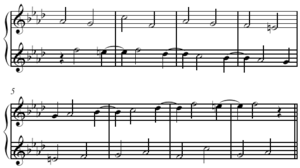Crab canon
A crab canon (also known by the Latin form of the name, canon cancrizans; as well as retrograde canon, canon per recte et retro or canon per rectus et inversus)[2] is an arrangement of two musical lines that are complementary and backward, similar to a palindrome. It originally referred to a kind of canon in which one line is played backward (e.g. FABACEAE played simultaneously with EAECABAF). An example is found in J. S. Bach's The Musical Offering, which also contains a table canon ("Quaerendo invenietis"), which combines retrogression with inversion by having one player turn the music upside down.
Sources
- Riemann, Hugo (1904). Text-book of simple and double counterpoint including imitation or canon, p.185. Breitkopf & Härtel.
- Kennedy, Michael (ed.). 1994. "Canon". The Oxford Dictionary of Music, associate editor, Joyce Bourne. Oxford and New York: Oxford University Press. ISBN 0-19-869162-9.
This article is issued from Wikipedia. The text is licensed under Creative Commons - Attribution - Sharealike. Additional terms may apply for the media files.
